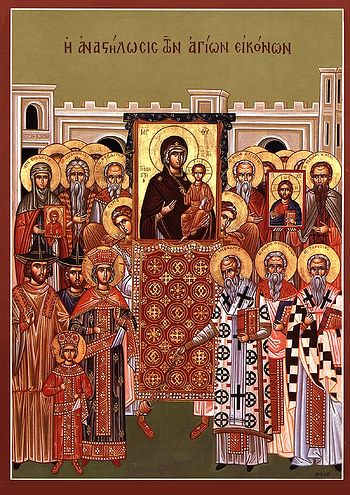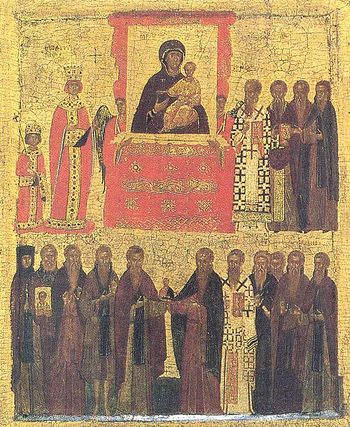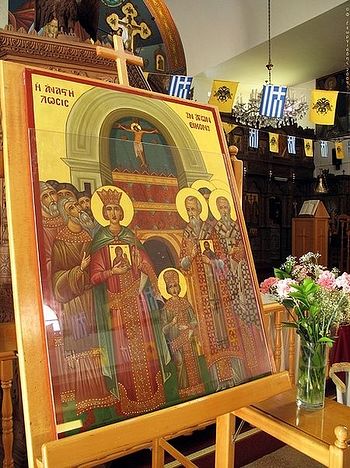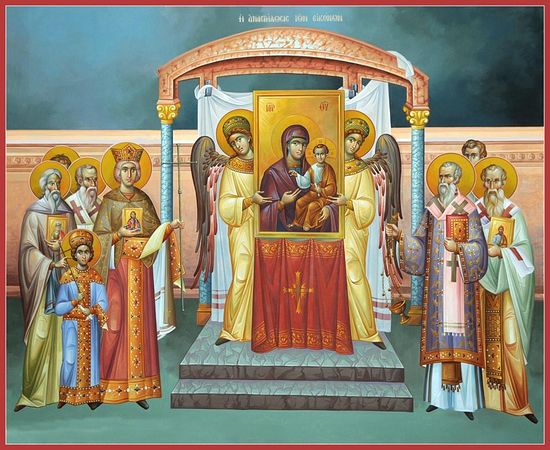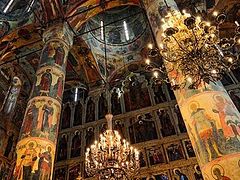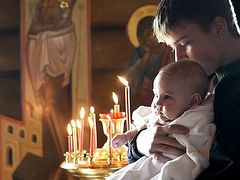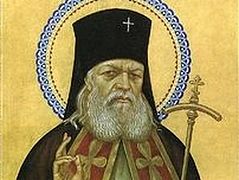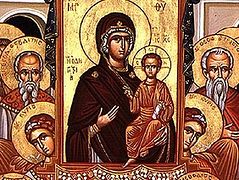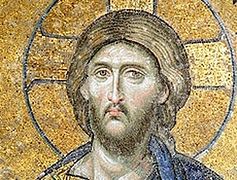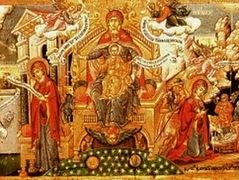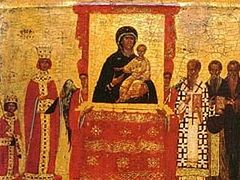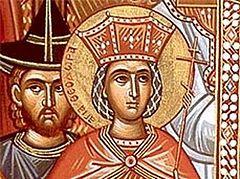Source: A Reader's Guide to Orthodox Icons
An icon celebrating the veneration of icons, the Triumph of Orthodoxy is the festal icon for the first Sunday of Great Lent. As Lent is a period of communal fasting which continues for seven weeks, such triumphalism early on is understandable: it helps to strengthen the faithful for the coming days. It is also understandable given the century of struggle which preceded the events in the Icon; years in which it seemed as though the Faith of the Church was overcome.
Outwardly the Icon is showing the result of a regional synod in Constantinople, held in 843 A.D., where the controversy over the veneration of Holy Icons was finally settled. The debate over whether images of Christ, His angels, and the Saints should be venerated, or even whether they should exist, raged for over a century. The word “debate” masks the nature of the controversy: since 726 A.D, various Byzantine emperors opposed to icons (iconoclasts) had used state-sponsored violence to strip churches of images, imprisoning, mutilating, and murdering those who continued to venerate the icons. Many priests and monks – who in the main venerated icons – fled to parts of the Church outside of the Byzantine Empire*: i.e. to Rome.
Upon the death of of the last Iconoclast emperor, Theophilos, his young son Michael III, with his mother the regent Theodora, and Patriarch Methodios, summoned the Synod of Constantinople in 842 to bring peace to the Church. The council affirmed the legitimacy of the Second Council of Nicea, which declared iconoclasm a heresy way back in 787, and declared:
“We define that the holy icons, whether in colour, mosaic, or some other material, should be exhibited in the holy churches of God, on the sacred vessels and liturgical vestments, on the walls, furnishings, and in houses and along the roads, namely the icons of our Lord God and Saviour Jesus Christ, that of our Lady the Theotokos, those of the venerable angels and those of all saintly people. Whenever these representations are contemplated, they will cause those who look at them to commemorate and love their prototype. We define also that they should be kissed and that they are an object of veneration and honour, but not of real worship, which is reserved for Him Who is the subject of our faith and is proper for the divine nature. The veneration accorded to an icon is in effect transmitted to the prototype; he who venerates the icon, venerated in it the reality for which it stands”.
After the conclusion of the council there was a triumphal procession from the Church of Blachernae to Hagia Sophia, restoring the icons to the church.
The Icon depicting this event is often named, in Greek, the Restoration of the Holy Icons (Η Αναστήλωσις των εικόνων). At the centre is the Icon of the Virgin Hodegetria, depicting the Theotokos as the “Directress”, pointing to Christ in her arms. This icon is believed to be the first one painted by the Evangelist Luke and so held a very special place in Constantinople’s history. The icon is held high by two angels, whilst gathered around are various saints and martyrs holding icons themselves. The number and identity of the surrounding saints can vary, but the ones shown in the icon at the top of this post are usually always shown. They are:
Top row (from left): St Theodosia (feast day May 29), Venerable Ioannikos (Nov. 4), Theodore of the Studion (Nov. 11), Theodore Graptus (Dec. 27), and Stephen the New (Nov. 28).
Bottom row: Regent Theodora, the young emperor Michael, and Methodius, Patriarch of Constantinople, who together convened the council (Jun 14); Michael, Bishop of Synnada (May 23), and Tarasius, Bishop of Constantinople (Feb 25).
Not all of the saints gathered were at the Council, and indeed some were murdered long before the synod was convened; all are presented in the Icon because of their unswerving defence of the Orthodox Faith regarding the veneration of icons. Other related saints sometimes shown include St John Damascene (Dec 4), St Theophylact (Mar. 8), and St Cassiane the Hymnographer (Sep 7).
All this happened on the first Sunday of Great Lent, which is why the Triumph of Orthodoxy continues to be celebrated on this day, often with processions of Icons.
As the Prophets saw, as the Apostles taught, as the Church has received, as the Teachers express in dogma, as the inhabited world understands together with them, as grace illumines, as the truth makes clear, as error has been banished, as wisdom makes bold to declare, as Christ has assured,
So we think, so we speak, so we preach, honouring Christ our true God, and his Saints, in words, in writings, in thoughts, in sacrifices, in churches, in icons, worshipping and revering the One as God and Lord, and honouring them because of their common Lord as those who are close to him and serve him, and giving to them due veneration.
This is the faith of the
Apostles;
This is the faith of the
Fathers;
This is the faith of the
Orthodox;
This faith makes fast the inhabited
world!
(From the Synodikon of Orthodoxy)

